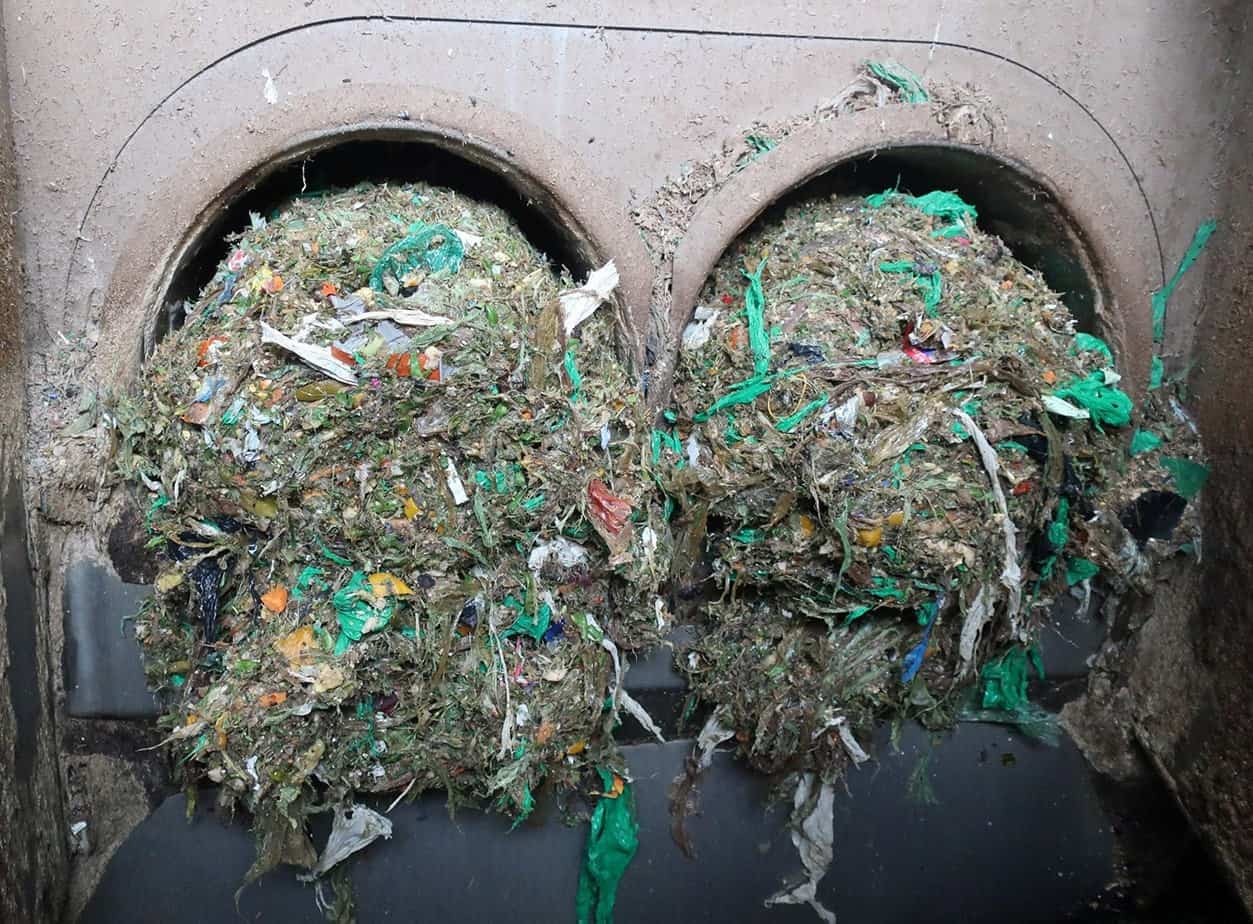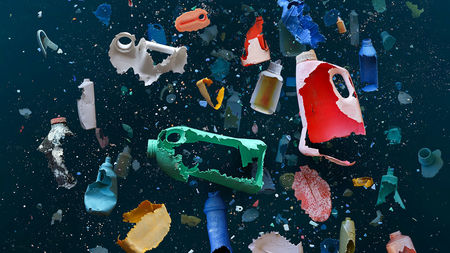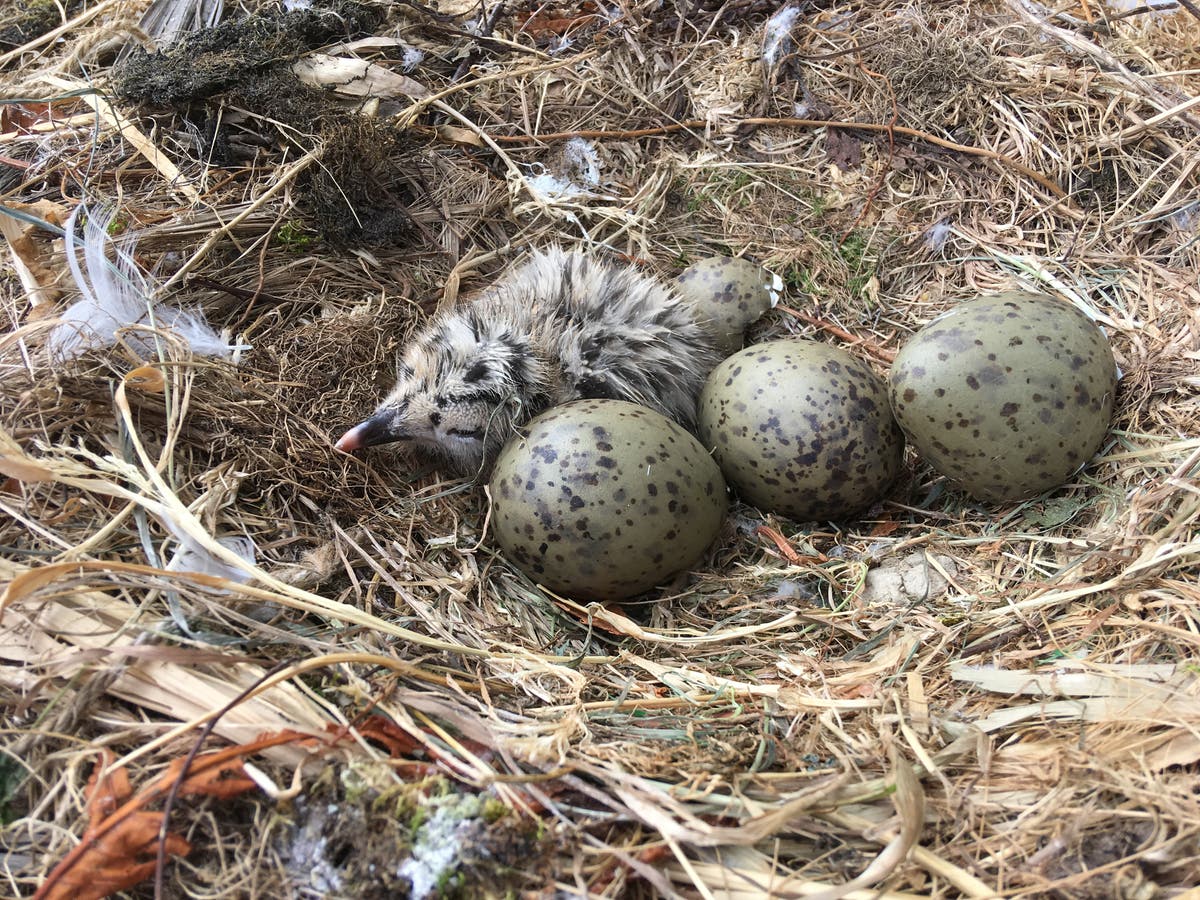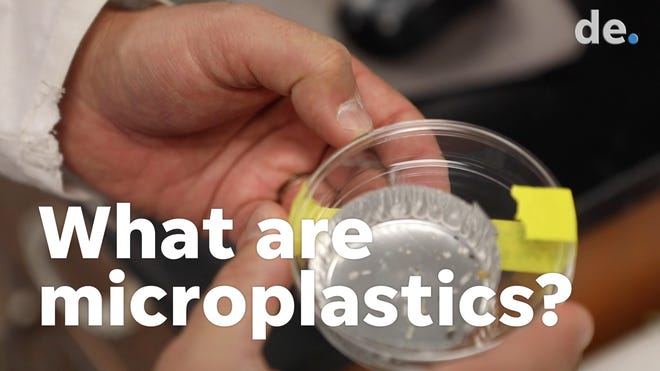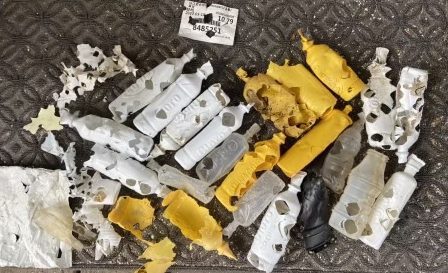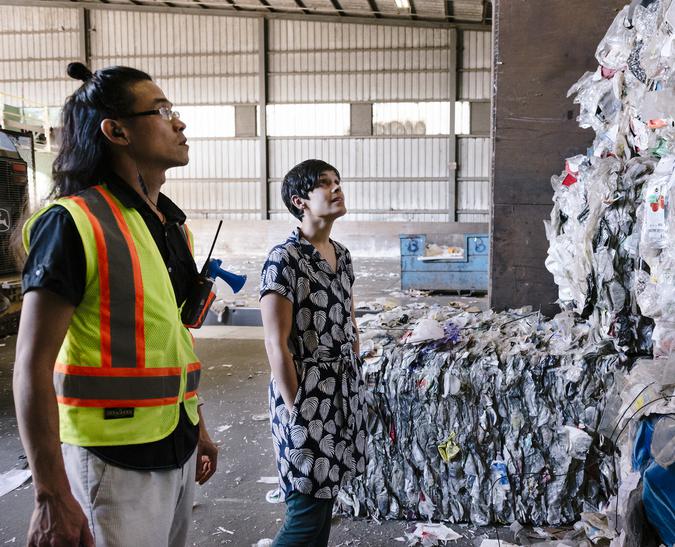The plastic in our oceans may have changed the planet… forever, according to new research.It has reached a tipping point – triggering effects we will not be able to reverse.Recycling schemes are failing to stem the tide. Capping production and banning waste exports is the last chance.Actions that drastically reduce emissions are “the rational policy response,” say an international team.Lead author Professor Matthew MacLeod, of the University of Stockholm, explained: “Plastic is deeply engrained in our society and leaks into the environment everywhere – even in countries with good waste-handling infrastructure.”The study in the journal Science found the pollution threat is getting worse despite better public awareness.Plastic is found everywhere on Earth – from deserts and mountaintops to deep oceans and Arctic snow.As of 2016, estimates of global emissions to the world’s lakes, rivers and oceans ranged from nine to 23 million metric tons a year. The same again is dumped on land.Quantities are expected to almost double by 2025 if business-as-usual scenarios apply.Co author Mine Tekman, a PhD candidate at the Alfred Wegener Institute, Bremerhaven, Germany, said it is also a “political and economic” issue.Current solutions, such as recycling and cleanup technologies, are not enough – and we must tackle the problem at its root.She said: “The world promotes technological solutions for recycling and to remove plastic from the environment.“As consumers, we believe when we properly separate our plastic trash, all of it will magically be recycled.“Technologically, recycling of plastic has many limitations, and countries that have good infrastructures have been exporting their plastic waste to countries with worse facilities.“Reducing emissions requires drastic actions, like capping the production of virgin plastic to increase the value of recycled plastic, and banning export of plastic waste unless it is to a country with better recycling.”Plastic accumulates when amounts exceed those removed by cleanup initiatives and natural outdoor degradation from sunlight, air and moisture.Co author Prof Hans Peter Arp, of the Norwegian University of Science and Technology, Trondheim, said: “Weathering of plastic happens because of many different processes, and we have come a long way in understanding them.Accumulation “But weathering is constantly changing the properties of plastic pollution, which opens new doors to more questions.“Degradation is very slow and not effective in stopping accumulation, so exposure to weathered plastic will only increase.”He describes plastic as a “poorly reversible pollutant”, both because of its continuous emissions and environmental persistence.Untouched places – such as the pristine polar regions – are most vulnerable.Co author Prof Annika Jahnke, of RWTH Aachen University, Germany, explained: “In remote environments, plastic debris cannot be removed by cleanups.“Weathering of large plastic items will inevitably result in the generation of large numbers of micro and nanoplastic particles as well as leaching of chemicals intentionally added and other chemicals that break off the plastic polymer backbone.“So, plastic in the environment is a constantly moving target of increasing complexity and mobility. Where it accumulates and what effects it may cause are challenging or maybe even impossible to predict.”On top of the damage it causes by entanglement of animals and toxic effects, there are a range of potential indirect environmental impacts.They include fuelling climate change by disrupting the global carbon pump and biodiversity loss in the ocean where plastic acts as an additional stressor to overfishing.Others are ongoing habitat destruction from changes in water temperatures, reduction in nutrients and more chemical exposure.The researchers hope taking all the findings together will provide “compelling motivation” for tailored actions.Added Prof MacLeod: “Right now, we are loading up the environment with increasing amounts of poorly reversible plastic pollution.“So far, we don’t see widespread evidence of bad consequences, but if weathering plastic triggers a really bad effect we are not likely to be able to reverse it.“The cost of ignoring the accumulation of persistent plastic pollution in the environment could be enormous.“The rational thing to do is to act as quickly as we can to reduce emissions of plastic to the environment.”1.3billion tonnes Last year a British study published in the same journal found 1.3 billion tonnes of plastic is destined for our environment – both on land and in the ocean – by 2040.The finding by the University of Leeds was based on a global model of the scale of the plastic problem over the next two decades.Another recent study by the University of Plymouth found a staggering 700 different species are threatened by plastic pollution – many of which are currently endangered.Earlier this year Greenpeace urged the UK government to ban the export of plastic waste to all countries, invest in a domestic recycling industry and set a binding target for plastic reduction.It also revealed how plastic waste from seven major UK supermarkets was being burned and dumped in Turkey rather than being recycled. It wants ministers to ban all exports of plastic by 2025.Related: Watch: Greta Thunberg has again slammed world leaders about climate change actionSince you are hereSince you are here, we wanted to ask for your help.Journalism in Britain is under threat. The government is becoming increasingly authoritarian and our media is run by a handful of billionaires, most of whom reside overseas and all of them have strong political allegiances and financial motivations.Our mission is to hold the powerful to account. It is vital that free media is allowed to exist to expose hypocrisy, corruption, wrongdoing and abuse of power. But we can’t do it without you.If you can afford to contribute a small donation to the site it will help us to continue our work in the best interests of the public. We only ask you to donate what you can afford, with an option to cancel your subscription at any point.To donate or subscribe to The London Economic, click here.The TLE shop is also now open, with all profits going to supporting our work.The shop can be found here.You can also SUBSCRIBE TO OUR NEWSLETTER .
Category Archives: Plastic Pollution Articles & News
Could plastic-eating microbes take a bite out of the recycling problem?
<!– –> Plastic trash recovered from an island in the South Pacific Ocean shows decay and bite marks from marine life. Mandy Barker By Warren CornwallJul. 1, 2021 , 2:00 PM Muhammad Reza Cordova is searching for treasure amid the water bottles, plastic bags, and plastic foam cups that choke the beaches, reefs, and mangrove …
Continue reading “Could plastic-eating microbes take a bite out of the recycling problem?”
Researchers are now using hurricane-tracking satellites to combat ocean microplastics
Have you ever wondered how scientists even begin to study things like patterns in ocean pollution and movements of microplastics? Better yet, you can probably imagine the people working the hardest to fight these problems could benefit from useful information like being able to track where a majority of microplastics come from in the first place? Surprisingly, initial methods to keep tabs on such things rely on reports from plankton trawlers, according to a new report from the University of Michigan, and those same researchers have introduced the use of some far more advanced machinery for their work: satellites.
The new tracking method employed by the UM team is taking data from a system of eight micro-satellites that were launched in 2016 to track storms. Creating measurements for what they’re calling “ocean surface roughness,” they were able to find a correlation between radar measurements used to track wind speed and the existing data from plankton trawlers and ocean current models already used to predict the movement of microplastics.
“Areas of high microplastic concentration, like the Great Pacific Garbage Patch, exist because they’re located in convergence zones of ocean currents and eddies. The microplastics get transported by the motion of the water and end up collecting in one place,” says Chris Ruf, the Frederick Bartman Collegiate Professor of Climate and Space Science at UM. “Surfactants behave in a similar way, and it’s very likely that they’re acting as sort of a tracer for the microplastics.”Advertisement
One of the team’s headline-making findings with this new tracking method is that concentrations of microplastics in a body of water can vary by season. For example, the Great Pacific Garbage Patch shrinks to its smallest size in January, the thick of the Northern Hemisphere winter. Six months later, microplastic concentrations are at their highest in the exact same region come summer. Meanwhile, the same cycle is flipped in the Southern Hemisphere. The researchers’ hope is that straightforward data like this can direct an organization like the Ocean Cleanup, helping them know when and where to deploy their resources. The same discovery also helped UM researchers narrow down some of the greatest sources of microplastic flow into the ocean, like China’s Yangtze River.
“It’s one thing to suspect a source of microplastic pollution, but quite another to see it happening,” Ruf said. “The microplastics data that has been available in the past has been so sparse, just brief snapshots that aren’t repeatable.”
Next up, the researchers are testing hypotheses from their findings and conducting experiments in a wave-generating tank to learn the relationship between surface roughness and the presence of microplastics. Small wins that they hope add up to big gains in fighting a gigantic environmental problem.
Seabird eggs contaminated with plastic additives – study
Herring gull eggs have been found to be contaminated with chemical additives used in plastic production, researchers said.A study looked for evidence of phthalates – a group of chemicals added to plastics to keep them flexible – in newly laid herring gull eggs.The research by the universities of Exeter and Queensland found up to six types of phthalate per egg.The chemicals function as pro-oxidants – potentially causing oxidative stress that can damage cells.Unfortunately, our findings suggest that mothers are inadvertently passing on phthalates and products of lipid damageREAD MOREProfessor Jon Blount, of the Centre for Ecology and Conservation at the University of Exeter’s Penryn Campus in Cornwall said: “Herring gull mothers pass on vital nutrients to their offspring via their eggs.“This includes lipids that nourish developing embryos, and vitamin E, which helps to protect chicks from oxidative stress that can occur during development and at hatching.“Unfortunately, our findings suggest that mothers are inadvertently passing on phthalates and products of lipid damage – and eggs with higher phthalate contamination also contained greater amounts of lipid damage and less vitamin E.”The researchers say the impact of their findings on developing chicks is not yet known, and further research is needed.They collected 13 herring gulls eggs from sites in Cornwall and all 13 were found to contain phthalates.Phthalates – which are used in most plastic products and readily leech out – can build up in living organisms by becoming concentrated in fatty tissues.While the study does not show where the gulls acquired the phthalates, they have been previously found in species preyed on by herring gulls, and the birds are known to swallow plastic.More research is now needed to discover how developing offspring are affected by being exposed to phthalates before they have even emerged as a hatchlingProf Blount said: “Research on the impact of plastic on animals has largely focused on entanglement and ingestion of plastic fragments.“Far less is known about the impacts of plastic additives on the body.“By testing eggs, our study gives us a snapshot of the mother’s health – and it appears phthalate contamination could be associated with increased oxidative stress, and mothers transfer this cost to their offspring via the egg.“More research is now needed to discover how developing offspring are affected by being exposed to phthalates before they have even emerged as a hatchling.”The study received an initiator grant from QUEX, and is published in the journal Marine Pollution Bulletin.
Cape Cod, New Bedford salt marshes contain microplastics, study finds
NEW BEDFORD — Walk by a salt marsh and you’ll see tall grasses, a glassy water surface and perhaps a few local bird species. By sight alone, the marsh may appear to be in its natural state.According to a new study, though, some marshes — built up for years and years by layers of sediment — contain countless plastic fragments and fibers under their surfaces, some so tiny they’re only visible through a microscope. Javier Lloret, a research scientist at the Marine Biological Laboratory in Woods Hole and a lead author, said the study is the first step in considering what implications microplastics have for salt marshes. “Humans are the ones producing these plastics that ultimately will break up into little tiny pieces, become microplastics and contaminate our environment,” Lloret said. “So one of the hypotheses that we started with was the idea of, if you have more people living in an area, if the area is more densely urbanized, the salt marshes in that area are going to have more microplastics in the sediment. It makes total sense from a common sense point of view, but it had not been tested yet.”And that’s what they found: the more urbanized the surrounding land was, the more microplastic fragments they found in the salt marsh sediment.For the study, researchers took sediment cores from salt marshes in Cape Cod and New Bedford. Each marsh had a different level of watershed development and population density, with the New Bedford site being the most urbanized. Keeping the environment clean:Volunteers collect trash in Fairhaven. Next, they’ll mail some back to the companies.While they found microplastic fragments and fibers in all sampling sites, they found a link between the number of fragments and level of urbanization. Specifically, the abundance of microplastic fragments in sediment samples increased as the degree of urban development on adjoining land increased.What was consistent across sites, though, was the amount of microplastic fibers — the material released from synthetic clothing or fishing gear. Regardless of the level of urbanization, fibers were equally abundant in the samples, Lloret said.Due to this distinction, Lloret believes fragments have a local source, whereas fibers may be sourced from the region as they can be transported more easily by wind or water. Reconstructing the history of microplasticsAt two of the Cape Cod sites, the scientists took deeper sediment cores to trace when plastic started appearing in the salt marsh. About 30 centimeters deep took them to the early 1940s, Lloret said, when plastic was rare and not widely used. While studying the cores, they found the number of microplastics increased dramatically closer to the surface.Salt marsh restoration:Climate change creates stress for homeowners battling erosion on Cape Cod”In the last 25 years, the number of [plastic] particles you find in the sediments was doubled,” he said. “If we continue these trends, in just a matter of another decade we can have a lot more microplastics, and the impacts that we’re still trying to figure out can be even worse.” What does this mean for salt marshes?Salt marshes are important ecosystems. They provide habitats for numerous species (including shellfish some people enjoy eating), protect coastlines against storm surges and sea level rise, and sequester carbon, Lloret said. They also act as effective “sinks,” with the grasses capturing materials — be it plant matter, dirt or plastic — and depositing it on the base of the marsh.’Drowning in place’: Mass Audubon begins work to protect Dartmouth salt marshLloret said this study was just the first step. It confirmed salt marshes contain microplastics and that levels are linked to human activity. However, the “million dollar question” that remains is what the presence of microplastics means for the health and functionality of the ecosystem. Filter feeders like mussels and clams don’t differentiate between a particle of food or a microplastic, Lloret said. If they consume plastic, it can affect their health as well as that of human consumers. “I’m very interested in the effects that it’s going to have in the food web, because those food webs are responsible for the functioning of the entire ecosystem,” he said. “That’s the kind of direction that I would like to go with this.” Until he and other researchers untangle those big questions, Lloret said municipalities and the state can consider actions, such as educating residents on recycling or establishing regulations that bar certain synthetic materials. The bottom line, though, is trying to use less things that are made of plastic, he said. Standard-Times reporter Anastasia E. Lennon can be reached at alennon@s-t.com. You can follow her on Twitter at @aelennon1. Support local journalism by purchasing a digital or print subscription to The Standard-Times today.
Plastic recycling could be more dangerous than you think
Efforts to end plastic pollution with recycling could leave people and the environment laden with poisonous chemicals, a new study has found. The report, which was not peer-reviewed, assessed four recycling and plastic waste management techniques that are poised to become more common as countries, including Canada, try to reduce plastic pollution. It found the main solutions promoted by the plastic industry — recycling, incineration, and transforming plastic into fuel — will increase people’s risk of exposure to a cocktail of toxic chemicals. Most plastic products contain toxic chemicals added to give plastic desirable traits, like flexibility or non-stick properties. When they are broken down during recycling or incineration, these toxins — everything from endocrine disrupters to cancer-causing chemicals — can escape recycling facilities and landfills to contaminate people and the environmentGet top stories in your inbox.Our award-winning journalists bring you the news that impacts you, Canada, and the world. Don’t miss out.“It doesn’t matter which of those methods you choose. The toxic additives in plastic are creating exposure to the point where it’s a detriment to human health,” said Lee Bell, report co-author and policy adviser on persistent organic pollutants to the International Pollutant Elimination Network (IPEN), an international coalition of environmental organizations that produced the study. That problem is exacerbated by recycling and other waste management techniques. For instance, chemical recycling — a suite of processes that break plastic down into its molecular components to make new products — produces a sludge of concentrated toxins. Techniques that transform plastic into fuel or to burn it to produce heat or electricity have similar issues, the report notes. The sludge or ash produced during these processes is typically put in landfills, used in landscaping or road construction, or spewed directly into the environment. Bell explained that, over time, these toxins end up leaching into the environment and contaminating soil, water, and the food chain. What people are reading Mechanical recycling — a common technique where old plastic is shredded and melted into new products — also concentrates toxic additives in the new products. Beyond the dangers the final products present to human health, the technique is expensive and struggles to compete with new plastics, Bell said. The problem is poised to get exponentially worse, with oil and gas companies anticipating that plastic production will make up the bulk of their future growth as the world transitions away from fossil fuels. Annual global plastic production is expected to more than quadruple in the next 30 years to reach 1.8 billion tonnes in 2050, according to the report. “That production schedule will swamp any attempts to deal with (plastic waste) from a recycling perspective,” Bell said. “The only way you can try to bring that into some sort of equilibrium is to try and cap production.”Yet countries have been reluctant to curb production.For instance, earlier this year, Canada listed plastic as toxic under its primary environmental law. The move was the first step in the federal government’s proposed plan to end plastic waste. Under the proposal, some single-use items would be banned and other restrictions implemented to boost Canada’s recycling capacity roughly six-fold by 2030. Efforts to end plastic pollution with recycling could leave people — and the environment — laden with poisonous chemicals, a new study has found. #Plastics Only about nine per cent of Canada’s plastic is recycled, mostly using mechanical recycling, according to a 2019 study commissioned by Environment and Climate Change Canada (ECCC). The remainder goes to landfills, is incinerated, or leaks into the environment. However, despite the decision to list plastic as toxic, the Trudeau government has yet to limit plastic production. “(ECCC) is working…to implement a comprehensive agenda for zero plastic waste by 2030. We are also taking action to develop recycled content standards and to hold producers responsible for their plastic waste. This approach seeks to transition Canada away from a linear economy that disposes of plastic as waste, and towards a circular economy that keeps plastic in the economy and out of the environment… Proposed regulations to prohibit or restrict certain harmful single-use plastics will be published for public comment later this year,” said Moira Kelly, press secretary to Environment Minister Jonathan Wilkinson, in a statement.“Unless we have a global treaty that limits plastic production in the same way the Paris Agreement seeks to limit carbon emissions, we are not going to be able to come up with a circular economy,” Bell noted. In a circular economy, plastic couldn’t contain toxic additives to make it more easily recyclable. It would also need to be limited to medical devices and other essential uses. “I don’t think it’s that far away, but we’re being held up by the petrochemical and fossil fuel companies from reaching that point,” he said. “The one thing they don’t want to hear is limits on production because if they can’t use (oil) as fuel and they can’t pump it into plastics production, they’ve got a problem.”
Increasing plastic pollution harming sea turtles along the Gulf Coast
Increasing plastic pollution harming sea turtles along the Gulf Coast | WKRG Skip to content ✕ × Close Ad
West Coast cleanup nets over 200 tonnes of marine debris
For weeks at a time, crews have been scouring remote sections of the West Coast — digging out massive fishing nets, hauling lines, tossing thousand of buoys and shifting mountains of Styrofoam to try to make a dent in the ocean refuse finding its way onto B.C.’s wildest shores. A shocking 210 tonnes of flotsam and plastic detritus was removed over six weeks from a mere 300 kilometres of the province’s intricate 25,000-kilometre shoreline during this year’s massive cleanup of the ecologically sensitive foreshores of the Great Bear Rainforest. “It’s just perpetual. It just keeps washing ashore,” said Scott Benton, executive director of the Wilderness Tourism Association. Get top stories in your inbox.Our award-winning journalists bring you the news that impacts you, Canada, and the world. Don’t miss out.“It’s a huge volume of garbage. And a very small portion of the coast when you consider how many kilometres of coastline there is in B.C.” The industrial-scale effort involved a fleet of nine small-ship ecotourism vessels crewed by 150 people who would have otherwise been out of work this May and June due to COVID-19 travel restrictions, Benton said. The undertaking also required an immense barge, a helicopter, a contingent of small boats and partnerships with the Kitasoo/Xai’xais, Gitga’at, Haisla, and Gitxaala nations. What people are reading Wilderness tourism staff collected fishing nets, thousands of buoys and mountains of Styrofoam to try to make a dent in the ocean refuse finding its way onto B.C.’s wildest shores. Photo Jeff ReynoldsBut the results speak for themselves as the enterprise, benefiting from previous experience, managed to almost double the 127 tonnes of trash picked up last spring during the inaugural launch of the provincial initiative, Benton said. In April, the province backed the initiative again, divvying up $9.5 million from the Clean Coast, Clean Waters Fund to four groups or associations in an effort to remove garbage from 1,200 kilometres of shore, or more than 100 derelict vessels along the north coast down to southern Vancouver Island. In addition to providing pandemic relief to the embattled wilderness tourism sector, the project was a response to the call for action around marine debris from coastal communities, said Environment Minister George Heyman. “It can feel like you’re putting a Band-Aid on an artery,” says Quadra Islander Breanne Quesnel on collecting marine debris. “But we live in this this beautiful place, and you just want to do what what you can to help, rather than hurt it.” Local governments and resident complaints involved derelict vessels, mooring buoys, polystyrene foam, aquaculture and fishing debris, and single-use plastics, he added. “The scale of the problem is massive, and we need to do much more to address ocean debris and its devastating impacts on marine life and food sources,” Heyman said. The vast majority of the ocean trash being removed from B.C.’s pristine shores is plastic, said Jeff Reynolds, a biologist and guide with Maple Leaf Adventures, who has been involved in the cleanup both years. Each year, globally, about eight million tonnes of plastic waste enters oceans. This translates to the dumping of a garbage truck of plastic into the sea every single minute. “It’s not just local, the debris is from all over the world,” Reynolds said.The gruelling work to collect it involved scrambling over rough terrain and tangled masses of driftwood to shift, pile, and sort garbage before loading it onto boats headed for the barge, or for pick up by helicopter directly from the beach. By weight, 50 per cent of what he and his crew mates wrestled from the shores exposed to the Pacific was nylon fishing nets or lines, Reynolds said. In terms of volume, crumbling foam from docks or floats, along with plastic buoys or floats, were the most common offenders. And then there were the ubiquitous plastic bottles. The team likely picked up around 90,000 of them, he said. Reynolds was heartened that this year rather than just dumping the debris in landfills, roughly 60 per cent of it was sorted for recycling. And despite the labour involved, the effort was worth more than just getting a paycheque during the pandemic, he said. “We all really care for this coast,” he said. “And there’s been a real incredible response, and I’ve enjoyed being part of such an impactful program.” Quadra Island Beach Clean Dream Team Quadra Island resident Breanne Quesnel and her sons Eamon and Rowan sort marine debris gathered by community volunteers. Photo by Rochelle Baker The past two years, the Clean Coast initiative has been the largest organized effort to clean the province’s shores in B.C. history. Yet for decades, most of the heavy lifting to clean B.C.’s beaches is typically done by community volunteers or non-profit groups (ENGOs) that often face funding, infrastructure or workforce hurdles. And the pandemic hasn’t made coastal community efforts to protect shorelines any easier, but some groups persevered regardless.When Quadra Island resident Breanne Quesnel saw her community’s annual spring beach cleanup cancelled due to COVID-19 for a second year, she felt she could help. Loads of dedicated individuals were still gathering garbage, but without the annual organized effort, there wasn’t anywhere to put it or any way to get a large amount of debris off the island, said Quesnel, co-owner of Spirit of the West Kayaking. So, Quesnel reached out to the regional waste management authority and collaborated to put a 40-yard collection bin in the parking lot of her business. With the costs covered by the regional waste authority, she helped set up a depot where islanders could sort and pile recyclables, and dump the rest of the debris for transport off island. “You know, we’re just a private entity, and we could provide the facility and some labour to help,” she said. “There are so many incredible volunteers on Quadra who have been busy collecting debris and stashing it, but needed a place to put it.” Quadra Island resident Nevil Hand organized the Facebook Quadra Island Beach Clean Dream Team so volunteers could co-operate to clean beaches during COVID-19. Photo courtesy Nevil HandNevil Hand, a retired firefighter, is one of the volunteers consistently walking the island’s shores. Frustrated that the pandemic had quashed yet another community cleanup, he organized a Facebook group, the Quadra Island Beach Clean Dream Team, as one way to organize and collaborate with other individual volunteers. “My motto is: Pick up what you can, where you can, when you can,” Hand said. People typically put the bigger beach trash in piles for pickup or use the social media group to communicate with one another about where they have cleaned. While the dumpster on the island has made things easier, it’s still a challenge to get any level of government to deal with larger items residents can’t manage due to lack of proper equipment or transport. Case in point is an enormous industrial marine bumper that washed ashore on one of the island’s remote beaches in the early spring and has yet to be removed by authorities or its owner. The structure is at least 60 feet long and made from loader tires and huge steel girders, he said. “It’s still there,” Hand said. “There’s no accountability. Government doesn’t want to find them and industries leave all their crap up and down the coast and let somebody else deal with it.” Quadra Islanders want more accountability from industry when it comes to cleaning up marine debris. Photo courtesy of Nevil HandAs a mom and business owner that benefits from the coast’s spectacular wilderness, Quesnel said making an effort is necessary despite the enormity of the ocean’s plastic problem. “It can feel like you’re putting a Band-Aid on an artery,” Quesnel said. “When you’re watching your kids play on the beach, you wonder what the ocean will be like when they’re older. “But we live in this beautiful place, and you just want to do what you can to help, rather than hurt it.”[embedded content]Rochelle Baker / Local Journalism Initiative / Canada’s National Observer
What comes after this plastic-filled pandemic?
When Jodi Sherman first started working in hospitals, she was struck by the amount of plastic used on a daily basis. She wondered how single-use plastics could be consistent with the Hippocratic oath’s first principle to “do no harm.”
“It’s clear that these materials come from somewhere and they go somewhere and they must be causing harm,” says Sherman, an anesthesiologist at Yale New Haven Hospital and founding director of the Program on Healthcare Environmental Sustainability at the Yale Center for Climate Change and Health.
But not all of her colleagues and patients see it that way, since plastic is an embedded feature of patient care. According to the Healthcare Plastics Recycling Council, 20–25% of all hospital waste in the United States is plastic—amounting to more than 1 million tons annually.
This wasn’t always the case—plastic’s prominence in hospitals dates back less than 100 years. But during the postwar plastic boom of the 1940s, medical professionals seized on its utility.
“The temptation for mass one-use disposal was irresistible,” says Robert Friedel, professor emeritus of history at the University of Maryland.
In Rome, a young girl is allowed to hug her father through a plastic tent. Photo by Filippo Monteforte/AFP.
That temptation was only amplified by plastic’s convenience, relatively low cost, and efficacy in certain situations, adds Friedel. Rigid plastics revolutionized products like the hypodermic syringe—historically made from glass—by making it cheaper to produce at scale.
Even the plastic straw—a source of modern consternation—has roots in medicine. In 1937, Joseph Friedman invented what we now know as the bendy straw, though his model was made from paper. His first sale was to a hospital, after nurses recognized its utility for patients with limited mobility.
“The medical community got away with it for a very long time, but the sheer volume of medical waste is beginning to catch up with them,” Friedel says.
Many medical facilities across the U.S. have some kind of recycling program, but market disruptions, factory closures, and pandemic-related shipping delays have introduced hurdles to seamless recycling.
“The recycling market for certain plastics in health care [is] very troublesome right now,” says Janet Howard, member engagement director with Practice Greenhealth, a nonprofit that, among other health care sustainability efforts, partners with medical providers to reduce waste. “We’d rather look for opportunities to go back to reuse.”
But getting medical professionals and patients to be comfortable with reused plastic that’s been exposed to a world of pathogens—especially in the middle of a global pandemic—can be tough. It involves getting over what Howard calls the “ick” factor of health care and undoing decades-old cultural beliefs in the sanitary nature of single-use plastics.
At a hospital in Oguchi, Japan, plastic sheeting divides sterile and non-sterile areas on a coronavirus ward. Photo by Carl Court/Getty Images.
Certain items, like small IV tubing and IV catheters, would be dangerous to reuse, Sherman says. But many other items can be. The World Health Organization reports that 85% of medical waste is not infectious. And evidence shows that many items could see a second life through Single-Use Device Reprocessing, though the process has its critics.
The process allows for the FDA-approved disinfection, cleaning, and remanufacturing of certain items with plastic parts like pulse oximeter sensors and tourniquets.
“The ‘single-use disposable’ label is not a regular label,” explains Sherman. “It’s a manufacturer-invented label. … Just because something is labeled ‘single-use disposable’ does not mean it can’t be reused.”
In other cases, the solution may be to revert to rigid, reusable plastics and glass containers, rather than the flimsy throwaways that replaced them.
Blue wrap is a conspicuous contributor to plastic waste in operating rooms. The #5, bright blue polypropylene plastic is used to sterile-wrap surgical equipment. The total amount of blue wrap waste is astonishing: One Canadian study found that just one type of surgery—total knee arthroplasty—generated more than 167,000 pounds of blue wrap waste from 2008 to 2009 in Canada.
At Boston Medical Center, unused ventilators are covered in plastic. Photo by Erin Clark/Boston Globe.
But Practice Greenhealth suggests that blue wrap can often be easily replaced with reusable hard cases that don’t need to be tossed after just one use. And they can save hospitals money along the way.
Hospital sharps containers offer another simple opportunity for reuse. Instead of chucking the whole container—used to safely dispose of needles and other sharp biohazardous waste—reusable containers can be taken to a processing facility to be emptied and disinfected.
Howard says the pandemic has highlighted how building out local supply chains, rather than banking on international manufacturers, can strengthen reuse and recycling projects.
“Our work [at Greenhealth] is really connected to community resilience,” Howard says. “The good news is that working with local businesses and putting down your roots in your community, investing in the local businesses, prepares you for crisis. And that could be extreme weather events, or it could be a pandemic. Whatever it may be.”
Jaime Kaiser
is a freelance environment journalist and audio producer based in New York City.
Bay Area group sues Coca-Cola over plastic pollution 'greenwashing'
A Bay Area environmental group is suing Coca-Cola for false advertising, accusing the multinational beverage corporation of “greenwashing” its image despite generating more plastic pollution than any other company in the world.The Earth Island Institute in Berkeley filed the lawsuit in the District of Columbia Superior Court this month, arguing that Coca-Cola cannot lawfully advertise itself as a sustainable or environmentally friendly company while generating millions of tons of plastic waste every year.
The complaint argues that the soft drink giant is deceiving consumers by using the word “sustainable” in its marketing and making unrealistic recycling claims.
“Coca-Cola will never be a truly sustainable company unless it moves away from its reliance on single-use plastic entirely, which it has no plans to do,” according to the lawsuit.
Coca-Cola spokesperson Ann Moore declined to comment on the lawsuit, but said in an email that the company recognized its “responsibility to help solve the global plastic waste crisis.” The company, she said, has committed to collecting “a bottle or can for every one we produce and recycle it” by 2030.

